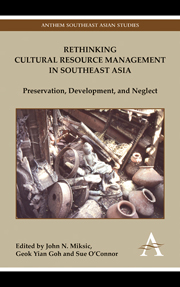Book contents
- Frontmatter
- Contents
- List of Tables and Figures
- Introduction: John N. Miksic
- Southeast Asia (General)
- East Timor
- Cambodia
- Chapter 5 Rethinking Cultural Resource Management: The Cambodian Case
- Chapter 6 Conservation of the Thnal Mrech Kiln Site, Anlong Thom, Phnom Kulen
- Chapter 7 Cultural Resource Management in Phnom Sruk: Potential and Problems
- Chapter 8 Archaeology and Cultural Resource Management South of Phnom Penh, Cambodia
- Chapter 9 Heritage Management of Wooden Prayer Halls in Battambang Province, Cambodia
- Myanmar
- The Philippines
- Singapore
- Vietnam
Chapter 5 - Rethinking Cultural Resource Management: The Cambodian Case
from Cambodia
Published online by Cambridge University Press: 05 May 2012
- Frontmatter
- Contents
- List of Tables and Figures
- Introduction: John N. Miksic
- Southeast Asia (General)
- East Timor
- Cambodia
- Chapter 5 Rethinking Cultural Resource Management: The Cambodian Case
- Chapter 6 Conservation of the Thnal Mrech Kiln Site, Anlong Thom, Phnom Kulen
- Chapter 7 Cultural Resource Management in Phnom Sruk: Potential and Problems
- Chapter 8 Archaeology and Cultural Resource Management South of Phnom Penh, Cambodia
- Chapter 9 Heritage Management of Wooden Prayer Halls in Battambang Province, Cambodia
- Myanmar
- The Philippines
- Singapore
- Vietnam
Summary
Introduction
When we define culture, we usually refer to past monuments and sculptures, literature, paintings etc. as tangible expressions, and music, dance, religious rituals, etc. as intangible expressions of art and culture. Cuisine (another expression of taste specific to each ethnic group) is also part of culture. Along with other countries situated between India and China, Cambodia participates in both influences. But in the era of globalization (when fast food tends to be a way of life), consumerism attached to fashion in the sense of a more casual way of living determines the trend that you must follow, such as a fashion show or a landmark of modernism or economic development in the form of high-rise buildings. How can we Cambodians manage and preserve our cultural resources, which are specific to our identity? The tragic social and political disruptions through the two communist regimes, especially from 1975 to 1991, deprived Cambodia of its traditions, continuity and intellectuals. It created a new situation characterized by a vacuum between the past (that the Khmer Rouge wanted to obliterate) and the present which lacks direction, concept and vision. This chapter presents the author's personal reflection on issues of cultural resources and heritage management in his home country, Cambodia, and addresses, in particular, his views on government legislation policies and the sustainability of unmitigated tourism development.
- Type
- Chapter
- Information
- Rethinking Cultural Resource Management in Southeast AsiaPreservation, Development, and Neglect, pp. 91 - 100Publisher: Anthem PressPrint publication year: 2011
- 1
- Cited by



